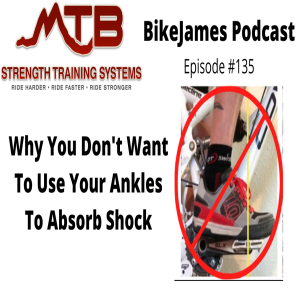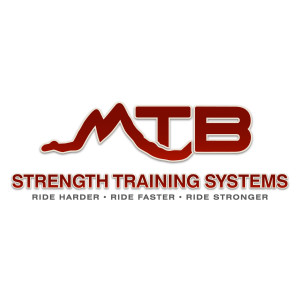
In this episode of the BikeJames Podcast I tell you why trying to use your ankles to absorb shock on your bike is a bad idea and actually makes it harder for your lower body to absorb shock properly. The notes for it also turned into an article, which you can read below if that works better for you...
One of my biggest surprises with bringing the Catalyst Pedal and the mid-foot position it allowed to the MTB world was the push back I got from the skills training industry. It turns out that the vast majority of skills coaches and organizations have bought into the false logic of needing the be on the ball of the foot to move properly on the bike.
The logic goes that you need your ankles to help absorb shock and that if you use the mid-foot position then it is like landing a vertical jump with flat feet, which is very jarring and obviously not the way to land a jump. The idea is that the range of motion of the ankle that is giving you the extra shock absorption that is making the difference in the two landings, which means that you need your ankles to absorb shock.
The problem is that, once again, people are pointing to analogies from other sports/ activities that don’t reflect the context of being athletic on the bike, i.e. the feet don’t come off the pedals.
When your feet come off the ground then you do need to use the ankles to help you land but even then they aren’t being used to absorb shock.
In fact, MTB is the only sport where coaches are actively looking to put extra stress on the ankle joint. It is known as one of the most sensitive and easily injured joints in the body and the goal is usually to minimize stress in order to avoid injuries.
The ankle joint is a small joint with a long lever arm, which magnifies stress being placed away from the ankle joint itself. It is not designed to absorb shock, it is designed to move itself (and the foot) into a neutral position to let the real shock absorbers do their work.
The hips are surrounded by the largest muscles in the body and have amazing leverage for both producing and absorbing shock. They are the shock absorbers of the lower body. Most lower body movement problems stem from not being able to use the hips properly, which makes using them efficiently a top priority.
But your foot has to be in a certain position and stabilized correctly to let the hips do their work in the most efficient way possible. If it isn’t then the hips can’t absorb as much shock, which places that stress on the knees and ankles.
This means that being on the ball of the foot screws you in two ways…
First, having the pressure point being so far away from the ankle joint increases the leverage and hence the force being placed on the ankle joint. This is why you’ll see people’s ankles buckle sometimes and in extreme cases Achilles tendon tears (ala Rachel Atherton a couple years back). This is why most DH riders actually run a more mid-foot position than you are led to believe.
Second, by having nothing under your heel you leave that end of the arch unstable, which makes it much harder to recruit and use your hips. The back of the arch has to be able to create pressure into something so that the hope can work efficiently. This is why you are told to not come up on your toes when doing deadlifts or squats and to drive through the whole foot, including the heel.
Even OL coaches tell people to “stomp” their heels back down to the ground to get their whole foot stable before the weight starts to come back down and they have to absorb it. If you really needed your ankles to absorb shock then they would cue their athletes to wait until the weight started to come back down and then use the ankles to help catch the weight.
And what about the vertical jump, which is the Holy Grail of analogies for this story? What you see during a vertical jump is the ankle moving to get the foot flat so that the hips can absorb the impact. Once again, it is not being used to absorb shock.
Another thing that a lot of coaches don’t want to talk about is that vertical jumping is only one example of jumping, with the broad jump being another. However, it doesn’t conform to their logic as you see the heels hit first on a broad jump as this is the best way to get the foot flat while going along with the momentum. If you needed land on the ball of the foot for the ankle to absorb shock in all instances then this wouldn’t be the case.
There are also a lot of examples where athletes absorb shock without using their ankles, including surfing, skiing, snowboarding and skateboarding. In the gym you see this with Swings, where you keep the foot flat on the ground because that is the best way to absorb shock in that context.
When you look at analogies from sports and activities that have the same context as MTB you see a clear picture, which is that you need to have both ends of the arch supported so the foot spreads out the forces going into the ankles and it is easier to recruit the hips. Even the broad jump is closer to what you want to do on your bike, as the explosive movements we make are wanting to project energy forward, not straight up.
On a personal level for you, the rider reading this, this is why your ankles are stiff and you have plantar fasciitis, knee pain or low back pain - being on the ball of the foot creates a crappy situation for your lower body where it has to adapt by getting stiff in the ankles and spreading force meant for the hips over the other joints that aren’t meant for it.
This is also why you have so much trouble moving properly when you stand up on your bike - your hips are locked up because of how unstable your feet are. It doesn’t matter how mobile you are off the bike, your ability to use it on the bike will always be compromised without the right foot position and support.
And yes, there are a lot of good riders who use a ball of the foot position. That is a testament to their mental focus and the human body’s ability to adapt to just about anything, at least in the short term. What you don’t hear about is how much pain those same riders are in or how hard they have to work to keep it under control (massage, chiro, cryo, etc.) and how it adds up over the years. There is a difference between adapting for the now and creating sustainable movement habits.
Just like the clipless pedal industry is still clinging to the “pull up on the backstroke” story to help the need to attach yourself to the pedals, we see a lot of well meaning skills coaches sticking with the “you need to use the ankle to absorb shock” story to sell the ball of the foot position.
And no, it isn’t a matter of “personal preference” or “what works for you might now work for everyone”. This is a nonsense argument that is used by people who can’t support their point of view. You should be able to give some sort of reason based in science, movement principles or context appropriate analogies or else you are just being what I call a “reality rager”, where you are mad at reality and refuse to deal with it.
Basic human psychology tells us that once you’ve created a story and you have sold other people on that story it gets tough to go back and admit that you were wrong, even if a better idea is presented (it is called the Semmelweis Effect after the guy who figured out that washing hands could save lives but got thrown in an asylum for his “crazy” ideas). But at some point the MTB industry needs this to happen so we can move forward with finding the best ways to perform on our bikes.
Lastly, if you’re a skills coach then you owe it to yourself and the industry to do more in the areas of how to apply basic movement principles to the bike. At the end of the day you are a movement coach as you are trying to help people move better on their bike, so you first have to understand how to help someone move better in the first place. This will also help you spot the countless false analogies and faulty logic used in our sport to sell people on outdated concepts.
Being on the ball of the foot to create or absorb energy is an old, outdated concept that we have to move past. Our sport isn’t very old and cycling as we know it is only around 150 years old so we have not had the time to work through the bad ideas like some other sports have. It is ok for us to have made a collective bad decision based on the best info we had at the time but it starts to become sad the longer we hang onto these ideas once they have been disproven and actually shown to work against us.
Until next time…
Ride Strong,
James Wilson
More Episodes
 2009-03-03
2009-03-03
 939
939
 2009-02-25
2009-02-25
 831
831
 2009-02-17
2009-02-17
 1.1k
1.1k
 2009-02-05
2009-02-05
 1.5k
1.5k
 2009-01-16
2009-01-16
 780
780
 2008-12-29
2008-12-29
 1.5k
1.5k
 2007-11-16
2007-11-16
 1.5k
1.5k
 2007-11-09
2007-11-09
 1.3k
1.3k
Create your
podcast in
minutes
- Full-featured podcast site
- Unlimited storage and bandwidth
- Comprehensive podcast stats
- Distribute to Apple Podcasts, Spotify, and more
- Make money with your podcast
It is Free
- Privacy Policy
- Cookie Policy
- Terms of Use
- Consent Preferences
- Copyright © 2015-2024 Podbean.com




